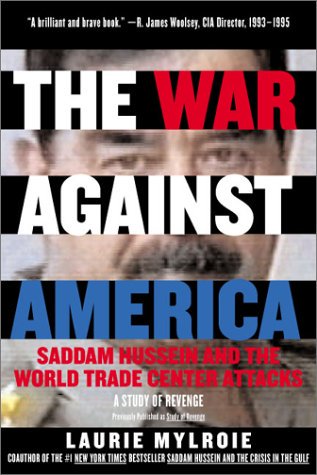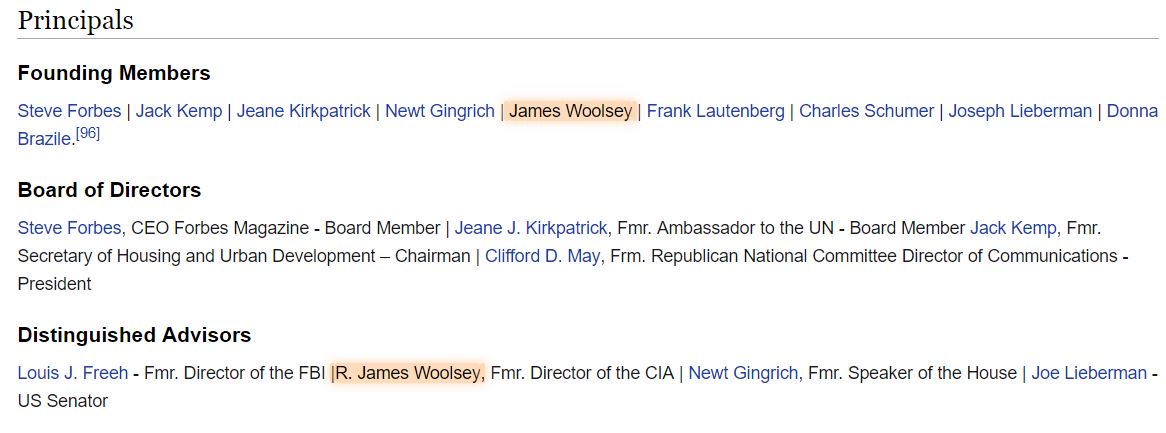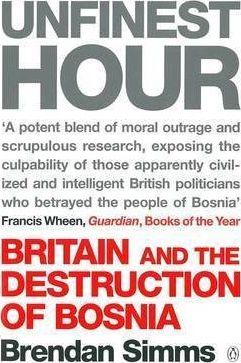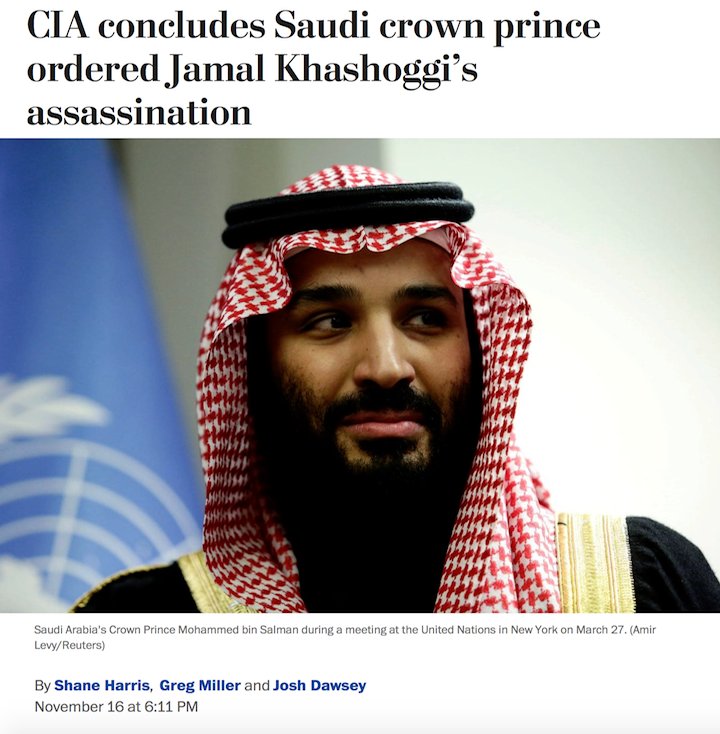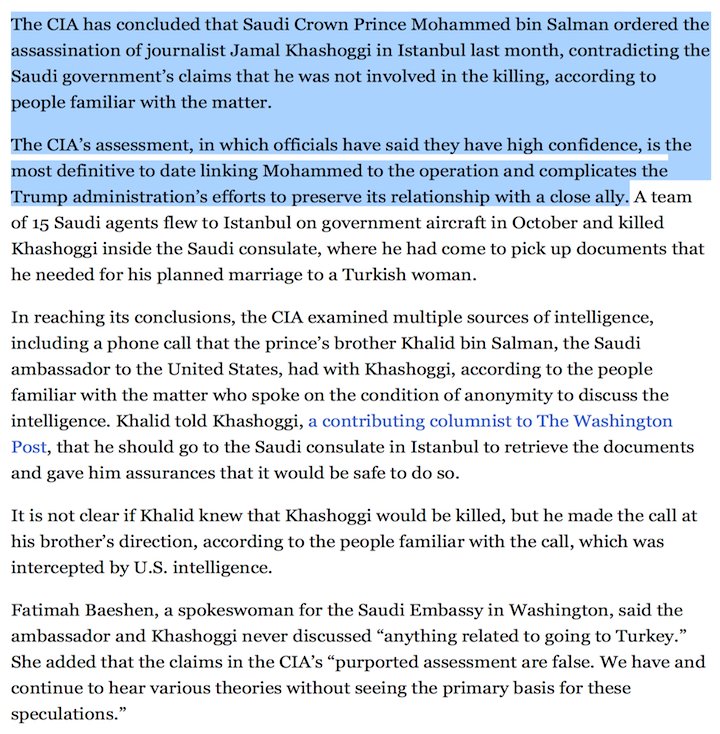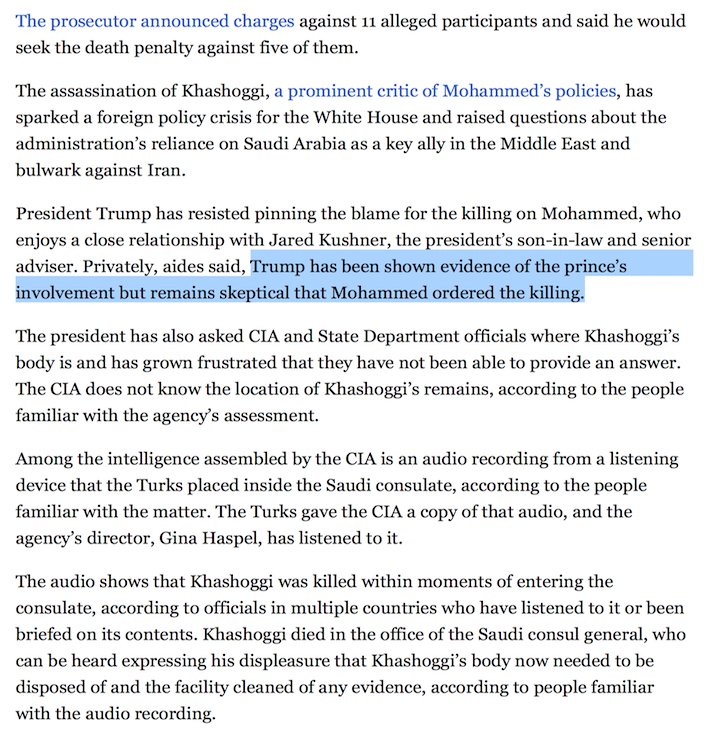That was my original question. I was vaguely aware of the name “James Woolsey.” I knew he was CIA director once. Seen him interviewed a couple times on cable news. That was the sum of my knowledge.
So I started digging. And kept digging...and digging….and digging….
Woolsey’s story is the story of the War Party over the last 20 years.
I selected certain names, locations, organizations and scenarios that oddly appear in both the run-up to the Iraq War and Spygate.
The information is so voluminous that I can’t expect anyone to read it all at once.
So his story will be presented in parts. Hopefully, this thread will be a resource for others.
Due to my limited knowledge of Woolsey, my search began without any preconceived expectations.
I tried let truth be my guide.
What I learned is that James Woolsey takes a very different approach to the truth.
Robert James Woolsey was born in Oklahoma, the son of conservative Democratic parents. He was smart. He attended Stanford University as an undergraduate, Oxford University as a Rhodes scholar and later received his law degree from Yale.
He was a socially liberal as a young man, involved in both the civil rights and anti-war movements.
As he matured, his politics began to moderate. Woolsey says he’s been a"'Scoop Jackson,' 'Joe Lieberman', Democrat all of my adult life”.
usatoday.com/story/news/pol…
As the anti-war faction of the Democratic party grew in the late 60’s in opposition to the Vietnam War, Jackson became the leader of the hawkish wing of the party.
He was dubbed the “Senator from Boeing” due to his consistent support for increased military spending.
Not all liberal hawks remained Democrats. Those who left to join the Republican party became the first generation of neo-conservatives.
For the purpose of this discussion, a liberal hawk/neo-conservative is a proponent of an idealistic, moralizing, uncompromising and interventionist foreign policy.
Woolsey’s tenure as the head of the CIA was short-lived. He resigned in Dec. 92.
He endorsed Clinton’s opponent, Bob Dole, in 1996.
Mylroie made that case that Saddam Hussein was behind numerous terrorist attacks against US targets, including the truck bombs at the World Trade Centre (1993) and the federal building in Oklahoma City (1995), as well as the Khobar Tower bombing in Saudi Arabia.
Woolsey alerted Bush administration officials to her book, and even helped her create a brief on Yousef.
Source: (Jacob Heilbrun, They Knew They Were Right)
On January 2, 2001, a break-in occurred at the Niger embassy in Rome. The items reported taken were of minimal value.
Little did anyone know at the time, the burglary would rival Watergate as the most important robbery in American history.
Among the items taken were official Niger government stamps, stationery and letterhead.
Soon after the 9/11 attacks, the CIA received a report from SISMI (Italian military intelligence) that an Iraqi official attempted to acquire uranium (“yellowcake”) from Niger. The report contained no documentation and was dismissed as amateurish by the CIA.
Vice President Dick Cheney was not satisfied. So the CIA sent retired ambassador Joseph Wilson to Niger to investigate. Wilson reported that he found no evidence that such a sell occurred.
One day after 9/11, Woolsey told journalist James Fallow, “no matter who proved to be responsible for this attack, the solution had to include removing Saddam Hussein, because he was so likely to be involved next time.”
theatlantic.com/magazine/archi…
On Sept 19, 2001, the Defense Policy Board, a bipartisan group of national security experts who advise the Pentagon, met for 19 hours to discuss what actions to take in the aftermath of 9/11.
.
Woolsey was on the board, along with such prominent names as Henry Kissinger, Richard Perle (chairman), Gen John “Jack” Sheehan, New Gingrich, Dan Quayle, and several former high ranking officials in the Pentagon
The New York Times reported that this group was nicknamed the “Wolfowitz cabal,” after Paul Wolfowitz, the Deputy Secretary of Defense at the time.
nytimes.com/2001/10/12/wor…
The group excluded Secretary of State Colin Powell, who was opposed to their proposal to invade Iraq and oust Saddam.
In October 2001, an article appeared in the New York Times about Iraqi links to WMDs and terrorism. It’s stunning how much fake news it contains, all from “intelligence sources” and “senior administration officials.”
nytimes.com/2001/10/27/wor…
The Prague connection was in the original draft of Colin Powell’s pre-war speech before the UN. Powell demanded it be taken out. He knew the intelligence was suspect.
Woolsey, however, was not troubled by such doubts. Or he was intentionally spreading disinformation.
Another tie between Saddam and terrorism in the article is Sabah Kohdada, a former captain in the Iraqi army who immigrated to the US. Khodada claims to have worked at a camp where non-Iraqi Arabs trained in terrorist tactics, including “hijacking of airplanes.”
It would later be revealed that US intelligence agencies did not believe Khodada’s story.
The INC ceased contact with him, but the damage was already done.
His story was part of the narrative, thanks to the authority of James Woolsey and the establishment press.
As far as the alleged meeting between Mohammed Atta and the Iraqi intel agent, turns out there was confusion over two different Atta’s (stop me if you’ve heard this before).
The presence of an Iraqi agent in Prague appears to have been no more than a rumor.
archive.boston.com/news/world/eur…
In the same month, an op/ed appeared in the Wall Street Journal written by Woolsey. It repeats the allegations of Iraqi agents in Prague and terrorists training camps in Iraq.
tca-reference-desk.blogspot.com/2001/10/iraq-c…
In the weeks after 9/11, Wolfowitz sent Woolsey to England to investigate possible links between Saddam and the 9/11 hijackers
James Woolsey is the absolute last person to send on a “fact-finding” mission.
I suspect his true purpose was to persuade the British that Saddam Hussein posed an imminent threat and that an invasion of Iraq was unavoidable.
On Oct 28, 2001, Rupert Murdoch’s London Times published the most outlandish article yet, “Hijacker Given Anthrax Flask by Iraqi Agent.”
The reporter, Dan McCrory, wrote that according to his sources Atta was handed a flask of anthrax in Prague by an Iraqi contact. He then flew to Newark, New Jersey and sent letters laced with anthrax to politicians and broadcasters.
McCrory also claimed that while in Rome, Atta contacted an Iraqi intelligence agent who was a professor at a school for diplomats.
After claiming there were more contacts between Iraqi agents and agents of Osama bin-Laden, McCrory finishes the article with James Woolsey’s hunt for al-Qaeda operatives in England.
One has to wonder if Woosley’s is not the source of most, if not all, of the information in the article.
This article is hard to find. The newspaper, I’m sure, would prefer it stay buried for eternity. I found a copy of the article posted on Free Republic.
freerepublic.com/focus/news/558…
Three months after 9/11, Paladin Capital, a private equity firm, was founded. The company “offers substantial promise for homeland security investment.” Woolsey is listed as a “principal.”
theguardian.com/world/2003/may…

(Paladin Capital is still going strong. Here’s a good rundown of the company's current activities.)
On December 20, 2001, an interview with Woolsey appears on the website Salon. Woolsey is the Bush administration’s “unofficial point man” for a possible war with Iraq.
The author states that Woolsey belongs to the “shadow government.”
salon.com/2001/12/20/woo…

When Mylroie’s book was reprinted in 2002, Woolsey added another glowing endorsement:
"After September 11 many, including myself, believe that the attacks may be the result of a partnership between the terrorists and a state with a sophisticated intelligence service and
....a program of biological warfare. If this proves to be true and Iraq is shown to be the terrorists' partners, there is no reason for anyone to ask, 'Why didn't someone warn us?' because Laurie Mylroie did."
Woolsey joined defense contractor Booz Allen Hamilton as a vice president in July, 2002.
domesticpreparedness.com/podcast/r-jame…

On Sept 24, 2002, the British government issued a dossier (“September Dossier”) claiming Iraq had “sought significant quantities of uranium from Africa.”
The British had received the same report from SISMI the CIA had received, but the British gov pushed the claim despite doubts about its authenticity.
The next month, an Italian reporter turned over documents, given to her by an unnamed source, to the American Embassy in Rome.
The papers were photocopies of a document on official Niger government letterhead, allegedly, approving the sell of yellowcake to Iraq.
When the reporter attempted to verify the documents herself, which included a trip to Niger, she could not.
When the CIA got hold of the documents, “they knew it was a fraud -- it was useless.” (Seymour Hersh, Who Lied to Whom)
In November of 2002, Bush’s deputy national security advisor, Stephen Hadley, a partner of Woolsey’s at Shea & Gardner, told an associate, Bruce Jackson, “they we’re going to war and we’re struggling with a rationale” and for Jackson to “set something up.”
Jackson, who also happened to be the director of strategic planning at Lockheed Martin, formed the Committee for the Liberation of Iraq.
Woolsey was named to the board of directors, along with the omnipresent Richard Perle. The committee was a leading proponent of regime change.
corpwatch.org/article/us-loc…
Despite the objections of numerous US intel officials, the charge that Saddam attempted to acquire yellowcake became an Administration talking point.
The accusation was included Bush’s 2003 State of the Union speech:
“The British government has learned that Saddam Hussein recently sought significant quantities of uranium from Africa”
On February 3, 2003, the British government released another dossier to the press on the organization of Iraq’s security apparatus and its attempts to conceal weapons of mass destruction. These documents would come to be known as the “Dodgy Dossier.”
Most of the 19 pages of the dossier were lifted straight from an article that appeared in the academic journal “Middle East Review of International Affair.”
Despite reprinting his article nearly word-for-word, the British government did not cite the author’s work. They never contacted him at all.
The rest of the dossier was composed of plagiarised material from two articles in Jane’s Intelligence Review.
When minor changes were made to the material, in every case it was in order to bolster the argument for Saddam possessing a potentially dangerous WMD arsenal. These changes were made without the authors’ permission.
casi.org.uk/discuss/2003/m…
All the information in the dossier was passed off as a product of British intelligence.
In late February of 2003, the Niger documents finally landed in the hands of Jacques Baute, head of the UN Iraq Nuclear Verification office.
After reviewing the documents with a team of experts, he determined they were “blatant forgeries.”
globalpolicy.org/component/cont…
On July 23, 2003, in a secret meeting of senior leaders in the British government, Richard Dearlove reported on his recent visit to Washington that..
...“Bush wanted to remove Saddam, through military action, justified by the conjunction of terrorism and [WMD]. But the intelligence and the facts were being fixed around the policy.”
The minutes of this meeting would become known as the Downing Street Memo.
Back on this side of the Atlantic, the supporters of regime change in Iraq continued their bid for control of the national debate by creating an echo chamber of think tanks and committees .
In Jan. 2003, Woolsey was named chairman of Freedom House.
The ever-prescient Pat Buchanan saw this drive to destabilize existing regimes as a continuation of Trotsky’s permanent revolution. (The Comintern, aka Communist International was created by Vladmir Lenin in 1919.)
original.antiwar.com/buchanan/2005/…

As the drumbeat for war continued to escalate, the Senate voted on a resolution granting President Bush the authority to enforce UN Security resolutions regarding Iraq. John McCain, speaking in favor of the resolution, warned:
“Saddam has developed stocks of germs and toxins in sufficient quantities to kill the entire population of the Earth multiple times. He has placed weapons laden with these poisons on alert to fire at his neighbors within minutes.”
Appearing on ABC’s Nightline, Bill Kristol said, “We’ll be vindicated when we discover the weapons of mass destruction.”
abcnews.go.com/Nightline/stor…

On April 3, 2003, Woolsey told a group of students at UCLA that the invasion of Iraq was the beginning of the “fourth world war.”
Not content with simply toppling Saddam, Woolsey warned that the rulers of Syria, Iran, Saudi Arabia and Egypt should all be “nervous.”
cnn.com/2003/US/04/03/…
In 2004, The Committee on the Present Danger was revived. In its previous form the CPD fought the threat of communism. Now its mission was fight “global terrorism.”
Woolsey joined Senator Joe Lieberman in the initial press conference, vowing “the committee intends to remain active until the present danger is no longer a threat, however long that takes,”
Later in 2004, IDT Energy was found in New York state. The company resells electricity and natural gas to residents and small business customers in NY and surrounding states. The company will play a major role as Woolsey’s story unfolds.
By 2005, the war in Iraq was becoming increasingly unpopular due the revelations of abuse at Abu Ghraib prison, the growth of sectarian violence and, perhaps most all, the failure to find weapons of mass destruction.
Supporters of military intervention were in retreat. Sen. Joe Lieberman was defeated in his party’s primary. The Project for the New American Century closed down.
Where did they retreat? To Cambridge University. England.
To be continued
CORRECTION: It was Michael Isikoff and David Corn who wrote about Tenet calling Dearlove in their book, Hubris: the inside story of spin, scandal, and the selling of the Iraq War (2006).
The initial British signatories on the Society’s State of Principals included numerous Conservative party politicians and a smaller of number of Labor pols.
The list also included 4 journalists, all from Rupert Murdoch’s London Times.
The influential Irwin Stelzer, an economist with the Hudson Institute and Rupert Murdoch’s “right hand man,” was a signatory.
File name: theguardian.com/media/2004/oct…
Other HJS signatories who have been mentioned previously in this thread: Bruce Jackson (Committee for the Liberation of Iraq), John “Jack” Sheehan (Defense Policy Board), Clifford May (Foundation for the Defense of Democracies) and, of course, Richard Perle
A Labor Party politician, David Clark, wrote a article in The Guardian heralding the Society’s inception. For his British readers, Clark explained who Henry Jackson was and addressed misconceptions about the “neoconservative movement.”
theguardian.com/politics/2005/…
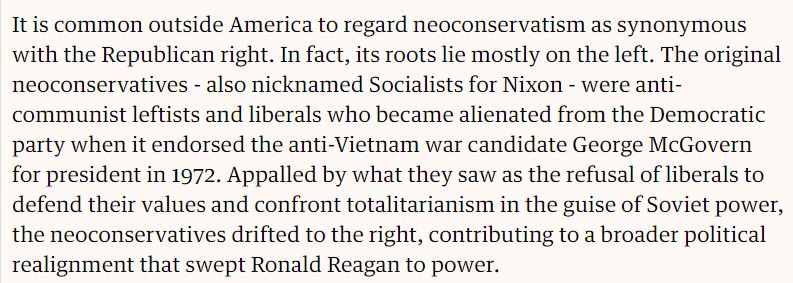
It’s Clark’s thesis that Britain during the Iraq War was comparable to the US during the Vietnam War.
The split within the liberal coalition over the war meant that there was the possibility of a new pro-military intervention coalition to emerge.
In the its infancy, the Society was devoted to bringing together neoconservatives and liberal interventionists to promote “commitment to universal human rights and the maintenance of a strong military with global expeditionary reach..”
An example of an intervention admired by the Society was NATO’s air support for rebel forces in the Kosovo War.
Madeleine Albright, Secretary of State in the Clinton Administration, was the leading proponent of the intervention.
content.time.com/time/magazine/…
"We are reaffirming NATO's core purpose as a defender of democracy, stability and human decency on European soil” -- Madeleine Albright
Meanwhile, back in the States, Woolsey’s support for the Iraq War was stronger than ever.
He saw the war as part of a larger “Long War” (Woolsey is the first prominent person I can find who used that term in relation to Iraq).
In the documentary (a work of war propaganda, tbh) Woolsey warns that the war will last for decades and require regime change in Syria and Iran.
This brings us to energy, a subject of much concern to Woolsey throughout his career.
He co-founded the Institute for the Analysis of Global Security (IAGS), “a non-profit think tank which directs attention to the strong link between energy and security.”
iags.org/staff.htm
In Sept 2004, IAGS, in conjunction with several other neocon think tanks (Foundation for the Defense of Democracy, Center for Security Policy, Hudson Institute), released an open letter to Americans urging them to reduce their demand for oil.
Here you can watch a speech on the on climate change and terrorism Woolsey gave at Harvard in 2008.
Even in front of a secular, scientific audience, Woolsey is prone to speaking in apocalyptic terms.
vimeo.com/74497226
In 2007, the Henry Jackson Society moved its headquarters to London. The staff was professionalized.
For my understanding of the Henry Jackson Society and its evolution, I’m indebted to the pdf, The Henry Jackson Society and the degeneration of British neoconservatism: Liberal interventionism, Islamophobia and the War on Terror.
purehost.bath.ac.uk/ws/portalfiles…
I have admit I find the authors insufferable. Everyone they disagree with politically is labeled “far right.” And I actually found myself sympathizing with the many of the Society’s positions.
Nevertheless, I can’t deny the quality of the authors’ research. They make a convincing case that over time the HJS drifted from its original mission of creating a bipartisan coalition as more and more money from pro-Israeli donors flowed in the Society’s coffers.
Despite the unpopularity of the Iraq War, in 2007, the supporters of military intervention rallied around the presidential campaign of John McCain.
McCain doubled down on the Iraq War, supporting the surge of additional US troops into the conflict.
He dubbed his campaign the “No Surrender” tour.
cbsnews.com/news/pure-hors…
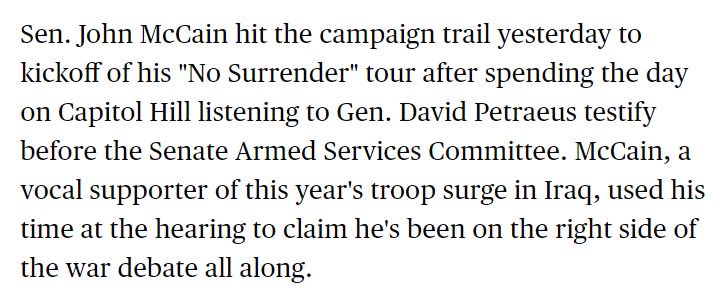
It’s not often remembered today that, early in his Senate career, McCain was a proponent of a measured, restrained foreign policy that’s hesitant to place American troops in harm’s way.
McCain opposed President Reagan’s deployment of US Marines to Lebanon as part of a peacekeeping force in 1983.
politicalticker.blogs.cnn.com/2008/10/07/fac…
By 1997, however, McCain was a full-blown hawk.
He co-sponsored the Iraq Liberation Act, committing the US to overthrowing Saddam Hussein and funding opposition groups. The most prominent group was the INC, headed by James Woolsey’s client, Ahmed Chalabi.
McCain’s foreign policy advisor on his 2000 and later 2008 president campaign was Randy Scheunemann, who drafted the Iraq Liberation Act.
Scheunemann was on the board of Project for The New American Century with Kristol and Woolsey.
newrepublic.com/article/60839/…
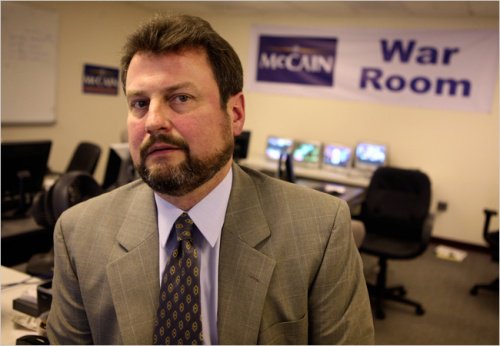
James Woolsey joined John McCain’s 2008 presidential campaign as a national security and energy advisor.
thehill.com/homenews/campa…
Brendan Simms, the president of the Henry Jackson Society, wrote enthusiastically that McCain would beat the Democratic nominee because he would been seen as stronger on foreign policy.
socialaffairsunit.org.uk/blog/archives/…

It should come as no surprise that the president of the HJS would be a supporter of McCain.
No other politician’s career more closely mirrors Jackson’s than John McCain’s.
Woolsey has never hesitated to call himself a “Scoop Jackson Democrat.”
For McCain, as a Republican (at least nominally), he could never so thoroughly identify himself with a politician from the opposition party.
However, he did embrace the title of “Maverick,” the moderate willing to cross the aisle to work with Democrats.
And like Jackson, McCain was a proponent of military intervention to “transform” and “shape” the policies of foreign countries.
McCain praised Jackson in several of his books and in front of numerous audiences, proclaiming Jackson was “the model of what an American statesman should be.”
washingtonpost.com/news/powerpost…
It’s from Jackson’s example that McCain obtained his concern for “human rights.”
In the early 1970’s, President Nixon and Henry Kissinger were attempting to gain Most Favored Nation trading status for the Soviet Union as part of of their effort to improve relations between the two nations.
A young member of “Scoop” Jackson’s staff, Richard Perle, devised a plan to undermine the administration’s attempts at detente.
Jackson introduced an amendment that would force the nations with “non-market economies” to allow increased immigration to obtain Most Favored Nation status.
Kissinger was furious.
However, as the the Watergate scandal crippled the Nixon Administration, Jackson was able to get enough votes for the Jackson-Vanik Amendment to pass.
Here was the birth of “human rights” as an objective of American foreign policy.
After the breakup of the Soviet Union, the tensions between the two countries lessened.
The Jackson-Vanik Amendment became a relic of the Cold War.










